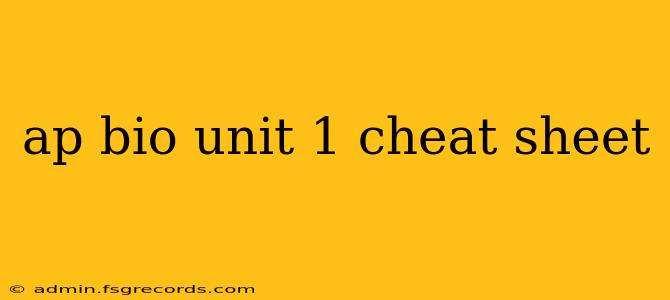This cheat sheet covers the essential concepts of AP Biology Unit 1, focusing on the chemistry of life. Remember that this is a supplement to your textbook and class notes—not a replacement! Understanding the underlying principles is key to success.
I. Water and its Properties
Water's unique properties are crucial for life. These properties stem from its polarity and hydrogen bonding:
- Polarity: Unequal sharing of electrons between oxygen and hydrogen atoms creates a partial negative charge (δ-) on oxygen and partial positive charges (δ+) on hydrogens.
- Hydrogen Bonding: The δ+ hydrogen of one water molecule is attracted to the δ- oxygen of another, forming a weak bond.
- Properties arising from these:
- Cohesion: Water molecules stick to each other (due to H-bonds). This contributes to surface tension.
- Adhesion: Water molecules stick to other polar substances. This is crucial in capillary action.
- High Specific Heat: It takes a lot of energy to change water's temperature. This helps regulate temperature in organisms and environments.
- High Heat of Vaporization: It takes a lot of energy to convert liquid water to vapor. This contributes to evaporative cooling.
- Excellent Solvent: Water dissolves many polar and ionic substances, facilitating chemical reactions within cells.
- Density Anomaly: Ice is less dense than liquid water, allowing aquatic life to survive in winter.
II. Carbon and Organic Molecules
Carbon's ability to form four covalent bonds makes it the backbone of organic molecules. Four major classes of organic molecules are essential for life:
- Carbohydrates: (C, H, O) Functions include energy storage (starch, glycogen) and structural support (cellulose, chitin). Monomers are monosaccharides (e.g., glucose), joined to form polysaccharides.
- Lipids: (C, H, O, sometimes P) Include fats, oils, phospholipids, and steroids. Functions include energy storage, insulation, and forming cell membranes (phospholipids). They are generally nonpolar and hydrophobic.
- Proteins: (C, H, O, N, sometimes S) Functions are incredibly diverse, including structural support (collagen), enzymes (catalysis), transport (hemoglobin), and defense (antibodies). Monomers are amino acids, linked by peptide bonds to form polypeptide chains, which then fold into complex 3D structures.
- Nucleic Acids: (C, H, O, N, P) DNA and RNA store and transmit genetic information. Monomers are nucleotides, each consisting of a sugar, phosphate group, and nitrogenous base.
III. Macromolecule Synthesis and Breakdown
- Dehydration Synthesis: Monomers are linked together by removing a water molecule. This is an anabolic (building up) process.
- Hydrolysis: Polymers are broken down into monomers by adding a water molecule. This is a catabolic (breaking down) process.
IV. Enzymes
- Enzymes: Biological catalysts that speed up chemical reactions by lowering the activation energy.
- Active Site: The specific region on an enzyme where the substrate binds.
- Substrate: The molecule upon which the enzyme acts.
- Enzyme-Substrate Complex: The temporary complex formed when the enzyme and substrate bind.
- Factors Affecting Enzyme Activity: Temperature, pH, substrate concentration, and enzyme concentration. Enzymes have optimal conditions for activity.
- Enzyme Inhibition: Competitive (inhibitor binds to active site) and non-competitive (inhibitor binds to a different site, changing enzyme shape).
V. Prokaryotic vs. Eukaryotic Cells
- Prokaryotic Cells: Lack a nucleus and membrane-bound organelles (e.g., bacteria).
- Eukaryotic Cells: Have a nucleus and membrane-bound organelles (e.g., plants, animals, fungi, protists).
This cheat sheet provides a concise overview. Make sure to consult your textbook and class materials for a more comprehensive understanding. Good luck with your AP Biology studies!

